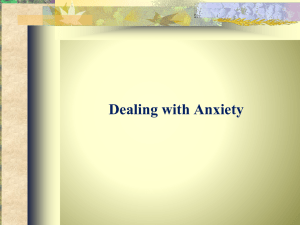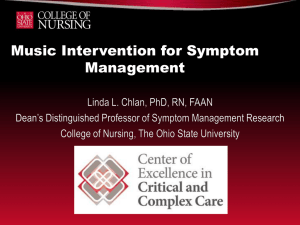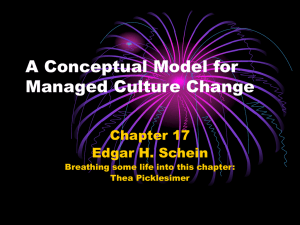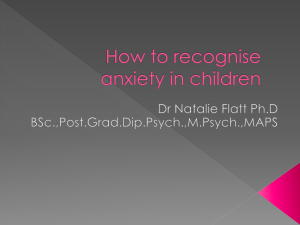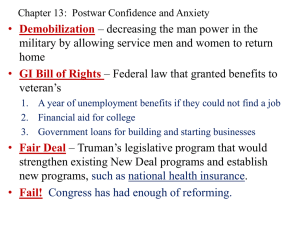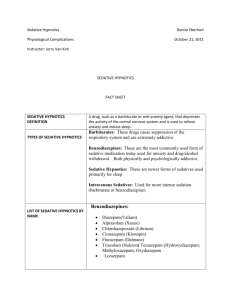Anxiety
advertisement
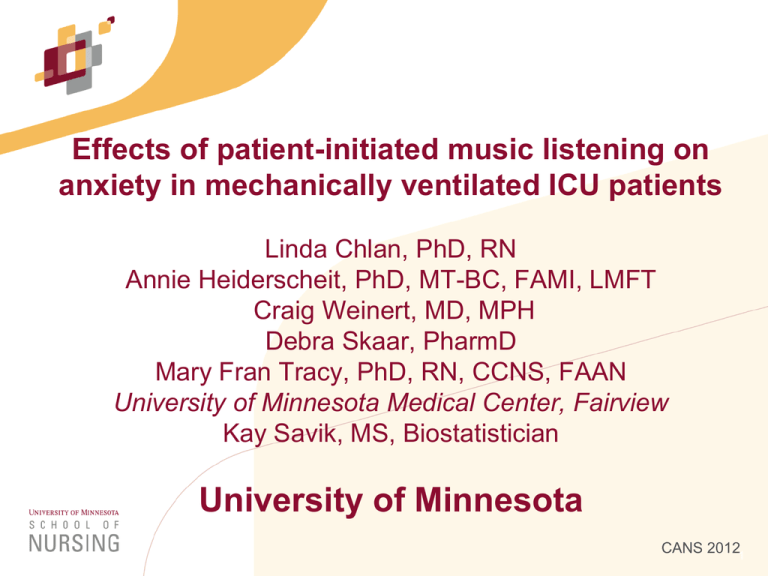
Effects of patient-initiated music listening on anxiety in mechanically ventilated ICU patients Linda Chlan, PhD, RN Annie Heiderscheit, PhD, MT-BC, FAMI, LMFT Craig Weinert, MD, MPH Debra Skaar, PharmD Mary Fran Tracy, PhD, RN, CCNS, FAAN University of Minnesota Medical Center, Fairview Kay Savik, MS, Biostatistician University of Minnesota CANS 20121 Special thanks to the Research Team Grant Support • NINR, NIH R01-NR009295 • L. Chlan, Principal Investigator • chlan001@umn.edu • Trial Registration #NCT00440700 BACKGROUND •Approximately 1 million patients receive mechanical ventilatory support yearly in the U.S. •55,000 adults admitted daily to ICUs in the U.S. •Commonly used ICU supportive modality –34% require ventilatory support for > 48 hours; increasing •ICUs are inherently stressful for patients and family •Distress from noise, lack of sleep, social isolation, frustration Patient Responses to Mechanical Ventilatory Support • Physiological Stress Stress of critical illness or infection + Delivery of mechanical breaths – Critical illness or injury – Lung injury – Ventilator associated pneumonia • Psychological stress • Anxiety: state; heightened arousal, tension, inability to concentrate • Fear • Feel miserable • Inability to speak; cannot convey needs, feelings, etc. Anxiety Ratings in Mechanically Ventilated Patients • Previous work limited to cross-sectional ratings • State Anxiety Inventory (score range 20-80) • < 5 days 48.6 + 12.0 • 6-21 days 50.2 + 12.5 • 22+ days 54.2 +11.9 • Chronic/long-term 45.8 +14.5 Chlan L. Description of anxiety levels by individual differences and clinical factor in patients receiving mechanical ventilatory support. Heart Lung 2003; 32:275-282. Patient Symptom Reports • 10-item checklist of physical and psychological symptoms (pain, tired, short of breath, restless, anxious, sad, hungry, scared, thirsty, confused) • Presence (yes/no), intensity (mild, moderate, severe), distress (not very distressing, moderate, very distressing) • 34% mechanically ventilated in two ICUs • Anxiety, thirsty, tired reported by 50-75% of assessments • No difference in intensity or distress if MV, except anxiety • Dyspnea most distressing; inter-related with anxiety Puntillo KA, Shoshana A, Cohen N, Gropper M. et al. Symptoms experienced by intensive care unit patients at high risk of dying. Crit Care Med 2010; 38:2155-2160. SUSTAINED ANXIETY Physiological responses: • SNS stimulation; CV responses; increased WOB and oxygen demand; myocardial stimulation Psychological responses: • Fear, inability to focus, inability to relax or sleep Usual treatment for anxiety is sedative medications – Limitations and adverse side effects Adjunctive Interventions • Can non-pharmacologic, adjunctive interventions reduce anxiety over the course of mechanical ventilatory support? – Limitations of sedative medications • In addition to medical plan of care • Relaxing Music intervention? Why Music Intervention and not just Sedative Medications? • Need for adjunctive interventions to reduce anxiety associated with ventilatory support • Sedative agents are warranted at times yet induce adverse effects • Not demanding for patients with communication challenges and low energy states • Safe and scientifically sound interventions • Does not induce adverse effects Scientific Basis of Music to Reduce Stress: Brief Overview • Music perceived as familiar and soothing • Interrupts the stress response; facilitates relaxation • Focused attention on pleasing stimuli of music reduces anxiety • Music can be a powerful distractor Music for Distraction • Preferred, familiar music can be a powerful distractor • Provides an alternative focus to a more pleasing, comforting stimulus, rather than focusing on stressful environmental stimuli or thoughts. • Important to assess music preferences, familiarity, cultural context Anxiety self-management for ICU Patients Receiving Mechanical Ventilation • Primary Aim: To determine if patient-directed music (PDM) reduces anxiety over the course of ventilatory support R01 NR009295 NCT00440700 DESIGN • Three-group randomized clinical trial • Remained on protocol as long as mechanically ventilated, up to 30 days • Subjects randomized to: • 1) Patient-directed music listening (experimental) – Preferred , relaxing music – Assessment of music preferences daily by music therapist – Allows choice, control, and self-management of anxiety – Prompts for PDM use • 2) Noise-canceling headphones (active control) • 3) Usual care (control) What is Relaxing Music? Conceptual Definition • Tempo at or below resting heart rate (60-80 bpm) • Predictable dynamics • Fluid, melodic movement • Pleasing harmonies • Regular rhythm without sudden changes • Simple compositions and soft tones SETTING and SAMPLE • 5 medical centers in the Minneapolis-St. Paul urban area • 12 ICUs total (medical, medical-surgical) • Adult critically ill patients receiving acute mechanical ventilatory support for a primary pulmonary component – Pneumonia, COPD, respiratory failure, pulmonary edema, etc. • Alert and interacting appropriately with nursing staff • Provide own informed consent – IRB and intervention requirements MEASURES • Anxiety – 100-mm Visual Analog Scale-Anxiety – Assessed similar time each study day • Illness severity (APACHE III) • Length of time mechanically ventilated • Length of ICU stay • All daily medications • Ventilator settings and weaning trials • Music Assessment Tool (experimental) Equipment for Experimental PDM Subject Characteristics • N = 373 enrolled; N = 286 considered for final analysis • Age = 58.5 +14.4; Range 21-88 • 52% female; 86% White, 12% Black, 1%Native American, 1%Asian • APACHE III 63.2 +21.6; Range 15-123 • 55% respiratory failure, 25% respiratory distress, 5% pneumonia, 3% COPD, 2% hypoxemia, 10% other • Median total ICU days = 17 (1-86) • Median total ventilator days = 10 (0-80) • 5.7 + 6.4 days on protocol; Range 1-30 days Participant Characteristics at Enrollment (N = 373) Patient-directed Headphones Music (n = 122) (n = 126) Usual Care (n = 125) p-value Age 60.4(15.4) 59.4(14.3) 57.8(13.5) .37 Male 58(46%) 66(54%) 56(45%) .28 APACHE III 63.1(18.7) 62.2(22.3) 65.6(23.5) .43 VAS-A 51.9 (32.4) 49 (30.1) 52.3 (29.7) .66 MUSIC PREFERENCES BY GENRES • Classical • Heavy Metal • Rhythm & Blues • World Music • Reggae • Oldies (1950-1970) • New Age/Contemporary • Rock • Country • Hip Hop • Jazz • Rap • Sacred/Religious • Pop Music • Alternative Rock • Other • Big Band RESULTS • Baseline anxiety 48.8 +29.3; range 0-100 – Moderate anxiety – Highly variable and individual symptom • PDM subjects listened to music 79.8 minutes/day • Headphones subjects wore them for 34 minutes/day Analysis of State Anxiety • Change by assigned group first assessed using scatterplots • Mixed-effects models for anxiety analysis • Included anxiety data on subjects with 3 or more data points to model change over time (N = 193) • Not all subjects able to report anxiety each day Visual Analog Scale-Anxiety Final Models Model 1/Model 2 β(se(β)) p-value Intercept 40.6(6.8) / 40.9(6.8) <.001 / <.001 Day -.54(.28) / -.51(.28) .052 / .08 Patient-directed music -26.3(7.1) / -26.9(7.0) <.001* / <.001* Headphones only -12.2(7.1) / -12.5(.08) .09 / .08 Final models control for APACHE III, sedative medications and interaction effects between treatment groups and VAS-A baseline; Usual care is reference group. 24 Mean VAS-Anxiety Controlling for Sedation Intensity Discussion of Results • Participants self-initiated music listening when desired – Individual control and management of highly variable symptom • PDM significantly reduced anxiety during mechanical ventilatory support – Anxiety reduced 26 points over time – Controlled for sedative medications • Patients report benefit with PDM use – “It’s the only thing that got me through….” • Control group did not have reduced anxiety over time Implications for Practice and Future Research • Beneficial, effective adjunctive intervention – No documented adverse effects – Integrate into ICU care; translation of findings to practice • Self-directed and preferred music allows for choice and control; empowers patients • Impact of PDM on other outcomes warrant future research – Ventilator-free days? – Weaning trials? • Influence on post-ICU outcomes is unknown “There are two means of refuge from the miseries of life: Music and cats”. ~Albert Schweitzer, 1875-1965 German medical missionary, theologian, musician, philosopher Thank you for your attention!




